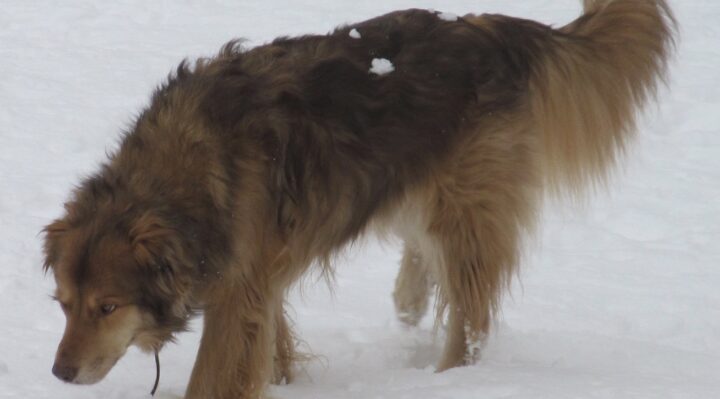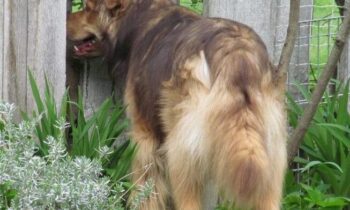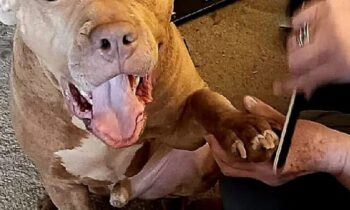

In late April, when my dog was diagnosed by our veterinarians as having dog dementia—Canine Cognitive Dysfunction, abbreviated as CCD—I was not thinking about how we would spend the winter. It was far away, and my dog, already a senior (about 11 or 12 years old), had symptoms that I was uncertain I could handle for that long.
I was wrong.
He had lost so much: his lifelong eagerness to eat all meals, his once faultless bite inhibition, his reliably excellent immediate recall.
It took months, but with much experimentation, frustration, and confusion for both of us, we somehow managed.
By summer, he was eating eagerly again, but not always the same food. He would be enthusiastic about a certain meal for weeks, then lose interest, leaving half of it uneaten. (I bought high-quality canned food from Petco, where you can return for a refund any food your pet won’t eat.) He settled on a texture he liked—mushy, with a little warm water. He never lost interest in the chicken and vegetable tube meat, so he gets that every night, too.
We came to an agreement about my fingers in his mouth. He hasn’t hurt me yet.
As fall got closer, I got worried. Our relationship had come close to idyllic, considering, but how would we survive a long, cold winter together when he would not come when I called him from the back yard? Last winter, long before he was symptomatic for CCD, he’d scared me badly several times by stalling out in heavy snow when his paws got icy and he would not walk. I myself could not then and cannot now walk safely in deep snow or on slippery surfaces. If he stalled out this winter, how would I get him back in safely?
His recall from the back yard was at that point not good.
I asked myself: What had changed? It was obvious: coming when called was no longer as rewarding to him as it had been for most of his life. He was choosing not to come when called. Why?
First, I acknowledged that there was now more interest at the fence line. Our neighbor in the house behind us was meeting my dog at the fence to visit and to give him treats several times a day. They’d been friends for a long time. She is a dog lover without a dog. Once she heard his diagnosis, she added the treats to their daily meet-ups.
I could not consider asking her to end that friendship! It was important to him, too.
When he’d ignore my calls to him to come back to the house, I’d walk down to the fence and encourage him to walk back with me, which he always did without objection. He’d often beat me to the back steps. I was more than willing to go to get him, but what about when I couldn’t? I got out my trusty long line and used it on him for practice when I remembered.
I listened to myself (not always fun) and admitted: There was a lot of ‘negative’ to his immediate recall between the fence line and the back steps. Positive to him, however! He liked to roll in the grass before he headed to me and, often, once again just before he got to the steps.
I was impatient, I tried to discourage the rolling and hurry him up—for no real reason! I grumbled at him when he took detours to amble in the ‘wrong’ direction. I gave more verbal negative than I gave verbal positive.
I knew better, I had to acknowledge. I had to do better … and before winter!

Photo by Val Hughes
I thought more. All sorts of possible negatives, too, were just inside the back door. In the kitchen was where I trimmed his nails, combed him out for the most awful mats, and gave him all his medications—prying open his mouth and sticking them down his throat—including the anti-anxiety pills, mobility pills, and pills for sleep. Unpleasant experiences all!
I moved the location of many of those experiences away from the kitchen. He now gets the mobility pills upstairs on the bed, followed by a beef or salmon jerky piece when he’s swallowed. He gets the sleeping pill on a soft biscuit in peanut butter, upstairs on the bed or in his kennel. He gets combed out and brushed on the bed, too, and his teeth cleaned as well.
He does get the anti-anxiety pills in the kitchen still, but he seems to find the meal that follows a reward for accepting that process. He’s as cooperative as possible now!
Okay. I’d removed most of what might have seemed to him the negatives of our interactions.
Next I had to figure out how to make coming when called far more rewarding.
I asked myself: What in his life does this dog find most rewarding?
I thought lots more!
He’s never been interested in toys, he’s never wanted to chase a ball. He enjoys showing off the tricks he knows but, in truth, my dog’s main interest in life seems to be … FOOD!
I listed for myself all the food treats he likes best. That’s when I realized he had a favorite, a format of food treat he’d never eaten until I’d been looking for something in which to hide pills and tried a new-to-him product (that didn’t work for hiding his pills) he’d come to love: it’s a premium meat roll.
“Happy Howie’s Soft Meal Roll Treats are like having fresh, home-cut deli meat for your dog! Their soft texture allows you to customize the portion to your dog’s size for use as a daily reward, food topper or even a training treat.”
He loved it!
I checked the freezer. Oops. We’d been out of Happy Howie’s for weeks. I ordered.
The day it arrived, I had a brainstorm: We had a new reward—we needed a new cue!
I was not going to use my voice to call him to come; that had not been working. I wanted a cue that was as unfamiliar to him as possible. I wanted no possible negative associations. It would have to be easy to perform/use, always available, and attention-getting for my dog.
I considered the possibilities that I already owned: a squeaky toy (used often on visiting dogs, the favorite of a doodle friend of ours), a whistle (from hunting obedience classes; it does not freeze to your lips … for hunters), or a duck call (that I had used when my golden was in a live production of Camelot and needed to do a recall from the stage).
Hmm.
Then I remembered a noise-making device that I’d owned for many years. Nothing to do with dogs or training, but if I could find it, it might work. “The original and only genuine Metropolitan English Police Whistle.”
I found it, still in the box, in a dresser drawer. I waited until my dog was outside, I went upstairs and, behind a closed door, I blew it.
YES!
I hustled downstairs, unwrapped a roll of the Happy Howie’s, and sliced it into pieces.
I waited until later, when my dog followed me into the kitchen, and I blew it again, took a few steps back. He smelled the Happy Howie’s, he knew what my stepping back meant, he whirled around and came right to me. He got a slice of Happy Howie’s! That worked.
I did it again. Blow whistle, step away from the dog, give him a slice, step away again in another direction, repeat. I knew not to repeat for long. Just a few minutes was enough.
He next heard the whistle when he was at the bottom of the back steps after he’d been out in the yard for a while. I had not called him, but he was hoping to come in, I thought, and was just waiting for me to open the back door.
I opened it, I blew the whistle, and—of course, he could smell and see the slices of Happy Howie’s I was holding—he rushed in!
I had no idea at that time how effective those first moments of ‘training’ would be.
I made mistakes. Wrongly timed whistles, when he was in the middle of a roll in the grass or just as our neighbor came out of her house to visit with him. I had to pay closer attention. I had to give him the best chance possible to respond immediately. I had to notice when he was just about to run to me; I had to know what that looked like so I could blow the whistle then.
The whistle as the cue with the Happy Howie’s as the reward. From that first day it worked, and works consistently when I time the cue correctly. My dog galloped to me when I whistled—“like a pup,” my neighbor texted, as happy about our success as I was.
It’s still working. It just did, moments ago. With heavy rain and some snow, in freezing cold.
Will it last through the winter? I can’t know that.
I can keep the Happy Howie’s coming (thanks, Amazon). I can pay attention to my dog. I can remember what I already know so that he can remember what he already knows.
I cannot leave the whistle in a pocket of a shirt that’s upstairs when I need it now downstairs, STAT.
I can enjoy the dog he is while we learn and relearn … together.



